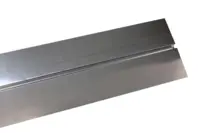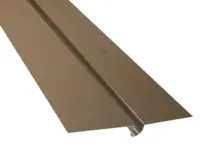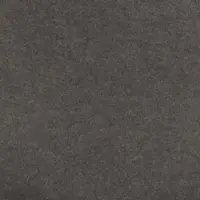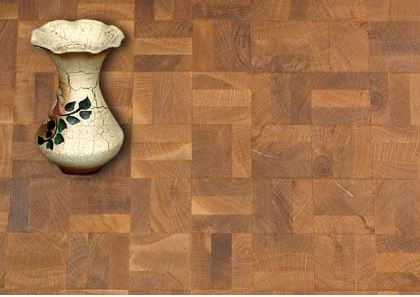- Forside
- Gode råd om gulv
- Gulvbelægninger
- Trægulve
- Materialer og typer
- Akustikpaneler
- Afpassede tæpper
- Bambusgulve
- Bordplader & bordben
- Designgulve
- Fliser og klinker
- BeefEater gasgrill
- Gode råd om gulv
- Gulvtæpper
- Gulvvarme
- Græstæpper
- Korkgulve
- Køkken, bad & garderobe
- Laminatgulve
- Linoleumsgulve
- Maling, Væv & Spartel
- Måtter
- Møbler & Boliginteriør
- Nålefilt og messetæpper
- Plejeprodukter
- Restpartier & gode tilbud
- Sildebensparket & Stavparket
- Tæppefliser
- Terrassebrædder
- Tilbehør
- Trægulve
- Vareprøver
- Vinylgulv
- Værktøj
- Øvrige produkter
- Loft- og vægpaneler
- Flotte gulve
- Fyrretræsgulv
- Klikgulve
- Bestilte varer
-
-26%
-
Populær29,00 DKK
-
29,00 DKK pr m2
-
Populær21,00 DKK
-
-59%39,00 DKK pr m295,00 DKKDu sparer: 56,00 DKK pr m2
Materialer og typer
Alle informationer på denne side er kopieret materiale fra Gulvfakta som er et fagteknisk opslagsmateriale, Kilde: Gulvfakta
Trægulve inddeles efter deres konstruktive opbygning i forskellige kategorier
Bærende gulve som kan underdeles i:
• Gulve på strøer
• Gulve på bjælkelag
Ikke-bærende gulve som kan underdeles i:
• Svømmende gulve
• Limede gulve
• Sømmede gulve
I dette kapittel gennemgås de mest brugt typer af trægulve.
1.7.1.1 Gulvbrædder
1.7.1.2 Parketbrædder
1.7.1.3 Stavparket
1.7.1.4 Parketruder
1.7.1.5 Mosaikparket
1.7.1.6 Lamelparket
1.7.1.7 Finerbrædder
1.7.1.8 Klodsegulv
1.7.1.9 Højkantparket
1.7.1.10 Klodsemosaik
Alle informationer på denne side er kopieret materiale fra Gulvfakta som er et fagteknisk opslagsmateriale, Kilde: Gulvfakta
1.7.1.1 Gulvbrædder
Gulvbrædder er massive brædder fremstillet af fyrretræ, gran, douglas mv. Løvtræ, fx eg og merbau, anvendes kun i mindre omfang.
Gulvbrædder er høvlede og pløjede brædder, der normalt findes i bredder fra 75 til 180 mm. og i tykkelser fra 14 til 30 mm. Standardvarer kan på bestilling leveres op til 40 mm. i tykkelsen og 450 mm. i bredden. Længden er almindeligvis mellem 1,8 og 5,4 m. Leveres der i faldende længder, kan nogle af brædderne i en leverance være kortere. Leveres der i faste længder vil en del af partiet, ofte 5-10%, blive leveret i kortere længder af hensyn til udnyttelse af råvaren.
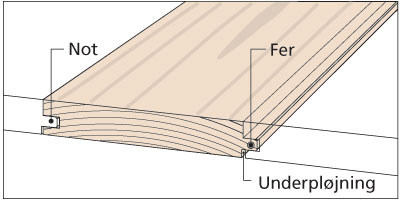 Fig. 1. Gulvbrædder.
Fig. 1. Gulvbrædder.
Bræddegulve betegnes undertiden plankegulve, selvom ingen af produkterne har tilstrækkelig tykkelse (høvlet, rettet mindst 42 mm.) til at kunne betegnes som planker. Brædderne har alene et plankelignende udseende.
Brædder, der er mindst 20 mm. tykke, kan lægges på bjælker eller strøer som et bærende gulv. Understøtningsafstanden skal afpasses efter tykkelsen og belastningen, se tabel 4 og 5. Ved mindre bræddetykkelser kræves fuld understøtning af gulvfladen.
1.7.1.2 Parketbrædder
Parketbrædder
Parketbrædder er massive enkeltstave, der på fabrik er sat sammen til brædder. Normalt anvendes der to parallelle rækker stave, der er samlet med en speciel svalehalesamling. Brædderne er forsynet med fer og not på alle fire sider, og findes i længder som almindelige gulvbrædder.
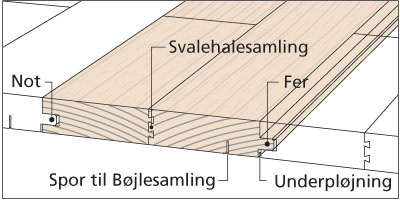 Fig. 2. Parketbrædder.
Fig. 2. Parketbrædder.
Parketbrædder kan lægges på samme måde som almindelige gulvbrædder, dvs. som bærende gulv, når bræddetykkelsen er mindst 20 mm., eller som sømmet gulv.
Parketbrædder kan også anvendes til svømmende gulve, som samles med bøjler eller clips (sammenlimning af brædderne er normalt ikke anvendelig til parketbrædder).
1.7.1.3 Stavparket
Stavparket
Stavparket er enkeltstave, normalt i massivt træ. Stavene er rektangulære med fer og not. Massiv stavparket findes også uden fer og not. Stavparket fremstilles af de traditionelle europæiske træarter som bøg, eg og ask, samt af en række oversøiske træarter, fx padouk, merbau, doussie, jatoba og wengé. Stavene er normalt 200-700 mm. lange og 50-70 mm. brede. Tykkelsen er normalt 15-22 mm. For stave uden fer og not må længden højst være 300 mm, og tykkelsen kan være ned til 10 mm. Parketstave udføres også som såkaldte langstave, der har en længde på 700-1200 mm.
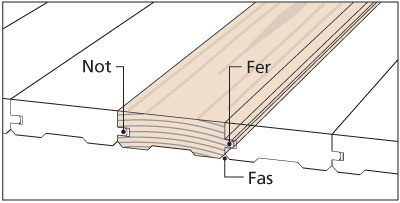 Fig. 3. Stavparket.
Fig. 3. Stavparket.
Et trægulv i stavparket lægges enten som limet eller sømmet gulv. Langstave, der er mindst 20 mm. tykke, kan tillige lægges som bærende gulv.
1.7.1.4 Parketruder
Parketruder er fremstillet af enkeltstave, der på fabrik er limet sammen til større enheder. Parketruder lægges normalt som limet gulv, men der findes enkelte typer, som kan anvendes til svømmende gulve, dog kun på mindre arealer.
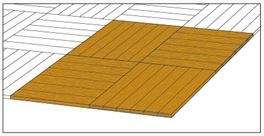
1.7.1.5 Mosaikparket
Mosaikparket er normalt 8 mm. i tykkelse, længden og bredden af stavene kan varierer fra fabrikat til fabrikat. Den mest almindelige stavstørrelse er 23 x 160 mm. Stavene limes på net og leveres i enheder der svarer til ca. 0,20 m². De 3 nedenfor vise mønstre er de mest almindelige
De hårde træsorter er de mest anvendte, med eg og ask som de dominerende, af de eksotiske træsorter er det merbau der oftest anvendes, men principielt kan alle hårde træsorter anvendes. Mosaikparket er et trægulv med mønster, der giver noget liv og spil til rummet.
Mosaikparket kræver et plant og tørt underlag. Felterne monteres i våd lim, det anbefales at man anvender en lim der ikke indeholder vand. Umiddelbart efter lægningen tromles parketten for at sikre at stavene presses ensartet ned i limen. Når limen er hærdet skal mosaikparkettet slibes, lakspartles og overfladebehandles. Produktionstolerancerne på mosaikparket er relativt store og der vil derfor være revner/sprækker mellem stavene efter nedlimningen. Efter gulvet er grovslebet (1.gang slibning) blandes slibestøvet med en speciel "kitvæske". Gulvet spartles med denne masse, hvorved revner o.a. fyldes med "lakspartel". Mosaikparket regerer hurtigere på ændringer i luftens fugtighed end anden massiv parket. Mosaikparket ligger bedst i et stabilt indeklima med små udsving i luftens fugtighed.
1.7.1.6 Lamelparket
Lamelparket er normalt opbygget som en trelagskonstruktion. Nederst et bundlag af nåletræ med fibrene i brættets længderetning. Et midterlag eller spærrelag af f.eks. spånplade, krydsfiner, MDF eller krydslagte lameller af hårdttræ eller nåletræ. Øverst et slidlag, som er mindst 2,5 mm. tykt, men som i de fleste lamelbrædder har en tykkelse på 3-4 mm. Slidlaget kan være udført af ét stykke finer eller opdelt som stavparket. Lamelparket fås derfor med udseende som gulvbrædder, parket eller mønsterparket. Et lamelparket er et trægulv, der er lunt og blødt at gå på, og som er yderst rengøringsvenligt. Et lamelparket kan fås i mange træsorter, såsom eg, fyr, bøg, mm.
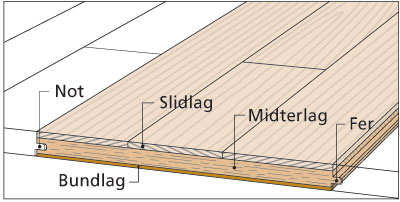 Fig. 5. Lamelbrædder.
Fig. 5. Lamelbrædder.
Lamelparket er forsynet med fer og not på alle fire sider og fås desuden med et låsende fer og not system (kliksystem), som overflødiggør brug af lim i fer og not ved svømmende gulvlægning. Lamelparket kan også lægges som limet eller sømmet gulv, eller som bærende gulv, hvis bredde-tykkelsen er mindst 22 mm.
1.7.1.7 Finerede brædder
Finerede brædder består af en træbaseret kerne, fx spånplade, MDF eller HDF. Slidlaget er en tynd, lakeret finer, der er under 2 mm. tyk. Bagsiden er "kontrafineret" for at modvirke spændinger i materialet, så gulvbrædderne forbliver plane.
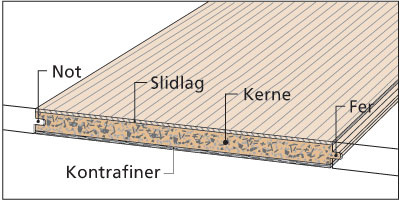 Fig. 6. Finerede brædder.
Fig. 6. Finerede brædder.
Finerede trægulve leveres med slidlag i en lang række træarter og med overflader som brædder eller med parketmønster. Finerede brædder lægges som svømmende, limet eller sømmet gulv.
1.7.1.8 Klodsegulv
Klodser er retvinklede træklodser fremstillet af eg, fyr, gran eller lærk. Længden af klodserne til klodsgulve bør ikke være mere end 1,5 gange bredden. Klodser findes i tykkelser fra 18 til 100 mm.
Klodserne nedlægges med fiberretningen lodret. De klæbes direkte til underlaget med en specialklæber.
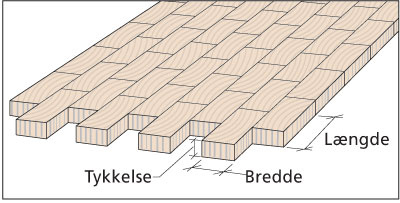 Fig. 7. Klodser.
Fig. 7. Klodser.
Det bedst egnede underlag er et stift træpladeundergulv. Klodserne kan også klæbes til et tørt betonundergulv. Endelig kan træklodserne nedlægges i sand. Klodser af bedste kvalitet kan lægges, afslibes og overfladebehandles, så de kan anvendes i forsamlingslokaler og boliger. Da overfladen på et klodsegulv er endetræ, optager det let fugt fra luften eller fra gulvvask. Derfor bør direkte fugtpåvirkninger undgås. Det anbefales altid at rådføre sig med leverandøren vedrørende fugtudvidelse og behovet for dilatationsfuger. Klodsegulve er særligt egnede til gulve i industrien, fx mekaniske værksteder, da de giver et robust og slidstærkt gulv samtidig med, at ting, der tabes på gulvet, fx maskindele og værktøj, er mindre udsat for skade.
1.7.1.9 Højkantparket
Højkantsparket leveres normalt i ca. 23 mm. tykkelse, men kan også leveres i ca. 10 og ca. 16 mm. tykkelse. Stavbredden er 8 mm, og længden er normalt 160 mm. En læggeenhed består af 40 stave på række, hvorfor enheden er 160 x 320 mm. Højkantsparket fremstilles af træarter som ask, eg, rødeg og merbau, og leveres ubehandlet.
 Fig. 8. Højkantsparket.
Fig. 8. Højkantsparket.
Læggeprocessen er den samme som læggeprocessen for mosaikparket. Højkantparket skal også lakspartles
1.7.1.10 Klodsemosaik
Klodsemosaik er tynde ca. 8 mm. endetræs skiver. Klodserne leveres limet på net i rudemønster. Hvert net er ca. 0,2 m². Størrelsen af de enkelte "klodser" kan variere en smule, men typisk er de ca. 60 x 20 mm. De hårde træsorter er de mest velegnede. Klodsemosaikken monteres på sammen måde som mosaikparketten. Klodsmosaikken er særdeles fugt følsomt. Den skal lægges i den bedste kvalitet lim og man skal sikre sig at limen og undergulvet kan klare de trækspændinger der vil opstå når klodsemosaikken opfugtes.

